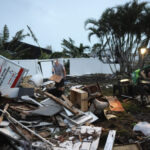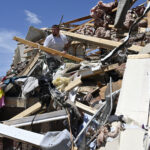Hundreds of homes were reduced to ashes Monday as wildfires blown by fierce desert winds raced across a huge swath of Southern California extending from Malibu to the Mexican border, forcing a quarter of a million people to flee.
At least one person was killed and dozens injured by more than a dozen blazes that formed a hellish, spidery pattern of luminous orange covering at least 240,000 acres, the equivalent of 374 square miles of the drought-stricken region.
The news got worse as the day wore on: Soon after nightfall, fire officials announced that 500 homes and 100 commercial properties had been destroyed by a fire in northern San Diego County that exploded to 145,000 acres, said Roxanne Provaznik, a spokeswoman for the California Department of Forestry. That fire injured eight people, including seven firefighters, and was spreading unchecked.
Firefighters — who lost valuable time trying to persuade some stubborn homeowners to leave — were almost completely overwhelmed as gale-force winds gusting to 70 mph scattered embers onto dry brush, spawning multiple fires in the same area. California officials pleaded for help from fire departments in other states.
“It was nuclear winter. It was like Armageddon. It looked like the end of the world,” Mitch Mendler, a San Diego firefighter, said as he and his crew stopped at a shopping center parking lot to refill their water truck from a hydrant near a restaurant.
At least 14 fires were burning in Southern California. From San Diego to Malibu, more than 150 miles up the Pacific coast, authorities said that at least 655 homes and 168 businesses or other structures had been destroyed.
“We have literally the perfect firestorm going on,” said San Diego County Supervisor Ron Roberts. “We’re a long ways from containment if there is such a thing given these winds.”
More than 265,000 people in numerous communities were warned to leave their homes, at least 250,000 residents in San Diego County alone. “It’s probably closer to 300,000,” Roberts said. More 200,000 reverse 911 calls — calls from county officials to residents — were made, alerting people to evacuate, he said.
Among them were hundreds of patients who were moved by school bus and ambulance from a hospital and nursing homes, many still in their hospital gowns and wheelchairs. Some carried their medical records in large zip-lock plastic bags.
About 80 miles northeast, in the mountainous Lake Arrowhead area, a two-front fire destroyed 133 homes in the same mountain resort community where hundreds were lost four years earlier. Air tankers that had been grounded because of high winds were back in the air fighting those fires by early evening.
One of the planes was a converted DC-10 airliner, the largest air tanker in existence. It quickly went to work laying down a huge curtain of flame retardant.
Meanwhile, in Orange County, a 1,049-inmate jail was evacuated because of heavy smoke. The prisoners were taken by bus to other lockups. That fire was believed to have been set by an arsonist.
A blaze threatening the homes of the rich and famous in Malibu might have been caused by downed power lines. Malibu residents forced to evacuate included Mel Gibson, Victoria Principal and Kelsey Grammer, none of whom lost homes, according to their publicists.
“Its a tragic time for California,” Gov. Arnold Schwarzenegger said in the oceanside city, where a church, homes and a mansion resembling a medieval castle were destroyed over the weekend.
Later Monday, Schwarzenegger toured San Diego’s Qualcomm Stadium, home to the NFL’s Chargers, where about 10,000 evacuees had spent the day huddled in eerie silence on the bleachers, staring at muted TV news reports. Others gathered in the parking lot with their pets, which were banned from the stadium.
The governor arrived to a more festive evening atmosphere, with live music and mountains of catered food. The crowd hooted and hollered as he passed through, and Schwarzenegger later declared that the people of this makeshift city “are very happy.”
Meanwhile, burning embers ignited spot fires in the neighboring ultrawealthy suburb of Rancho Santa Fe, north of San Diego. The embers started fires in lemon orchards and smoke choked the air around gated mansions. South of the city, in Chula Vista, authorities issued yet more orders to leave.
The blazes in San Diego County and elsewhere erupted one after another. Several new fires started Monday, while others merged. Parts of seven Southern California counties were ablaze.
All San Diego police officers and detectives were ordered to return to work to help move people to safety and handle other fire-related emergencies.
Firefighters complained that their efforts to stop the flames were delayed when they were confronted by people who refused to leave their homes.
“They didn’t evacuate at all, or delayed until it was too late,” said Bill Metcalf, a fire boss.
Tom Sollie, 49, ignored evacuation orders in the city’s Rancho Bernardo area to help his neighbors spray roofs on his street with water. His home was untouched, but he watched a neighbor’s house reduced to nothing but the remnants of a brick chimney. “The house went up like a Roman candle,” Sollie said.
He added: “If we weren’t here, the whole neighborhood would go up. There just aren’t enough fire trucks around.”
As flames, thick smoke and choking ash filled the air around northern San Diego County’s Lake Hodges, Stan Smith ignored orders to leave, staying behind to help rescue his neighbor Ken Morris’ horses.
“It’s hard to leave all your belongings and take off, and the bad thing is you can’t get back in once you leave,” Smith said.
Besides, said Smith, “Lots of time the fire doesn’t ever come. It’s come really close before. I’ve seen it so bad you couldn’t even hear yourself talk over the flames and ash blowing everywhere.”
Black smoke blanketed much of northern San Diego and nearby suburbs as flames hopscotched around homes in Rancho Bernardo, a community with a large number of elderly people, destroying one of every 10 homes on one busy street.
Highways, canals and other features normally act as firebreaks. But the towering flames and flying embers rendered them useless this time.
Dozens of motorists gathered on an Interstate 15 overpass in San Diego to watch flames race up a hillside and engulf at least a half-dozen homes. Witnesses said they watched flames jump west over the 10-lane freeway.
“The flames were like 100 feet high and it moved up the hill in seconds. It was at the bottom, it was in the middle, and then it was at the top,” said Steve Jarrett, who helped a friend evacuate his home in nearby Escondido.
Fire near the San Diego Wild Animal Park led authorities to move condors, a cheetah, snakes and other animals to the fire-resistant veterinary hospital on the grounds of the park. The large animals, such as elephants, rhinos and antelope, were left in irrigated enclosures.
The world-famous San Diego Zoo was not immediately threatened.
In Fallbrook, northeast of San Diego, a quick-moving fire that began Monday forced thousands to flee. Marine officials at neighboring Camp Pendleton opened the base to residents fleeing the flames.
The San Diego fire closest to the Mexican border was responsible for one death. More than a dozen people were hospitalized with burns and smoke inhalation, including four firefighters, three of whom were listed in critical condition, officials said.
Some of the injured were hikers, while others may be illegal immigrants. Among the evacuees were members of a National Guard unit that had to flee its barracks.
In late October and early November of 2003, 15 fires in many of the same areas killed 22 people and destroyed 3,640 homes. Ten years earlier, in October and November of 1993, 26 fires in those areas killed four people and damaged or destroyed 1,200 structures.
Was this article valuable?
Here are more articles you may enjoy.

 Harvard Settles Lawsuit by Former Student Claiming Antisemitism
Harvard Settles Lawsuit by Former Student Claiming Antisemitism  UBS Client Can’t Sue Bank Over Broker’s Alleged Affair With Wife
UBS Client Can’t Sue Bank Over Broker’s Alleged Affair With Wife  Here Comes Another Busy Atlantic Hurricane Season, But Will It Be as Crazy as 2024?
Here Comes Another Busy Atlantic Hurricane Season, But Will It Be as Crazy as 2024?  Central US Severe Weather Outbreak Caused Billions in Damages, AccuWeather Says
Central US Severe Weather Outbreak Caused Billions in Damages, AccuWeather Says 